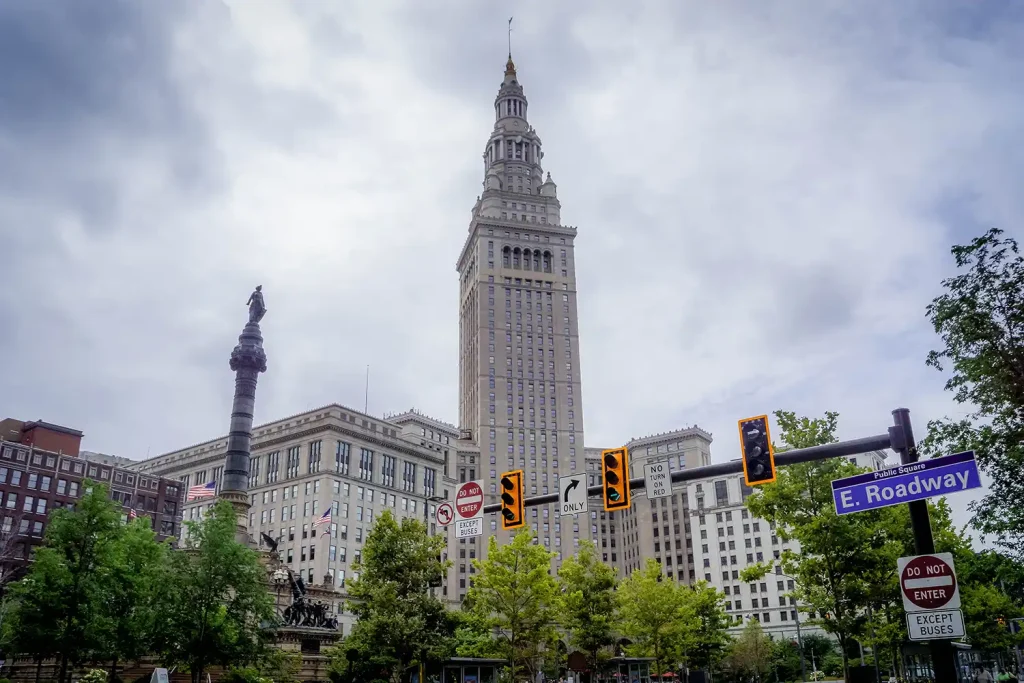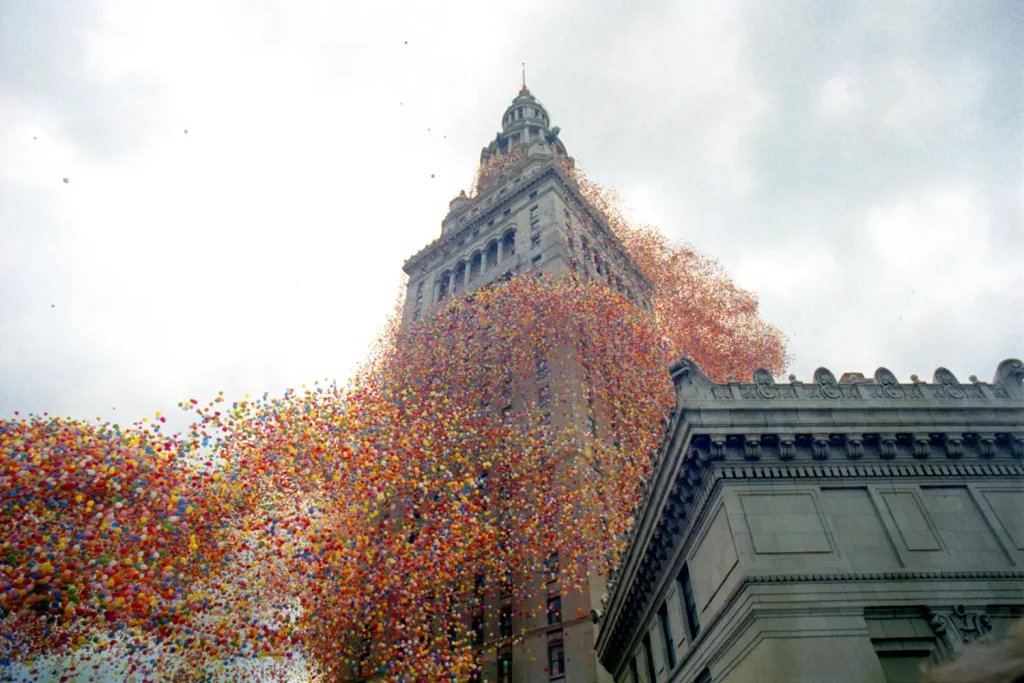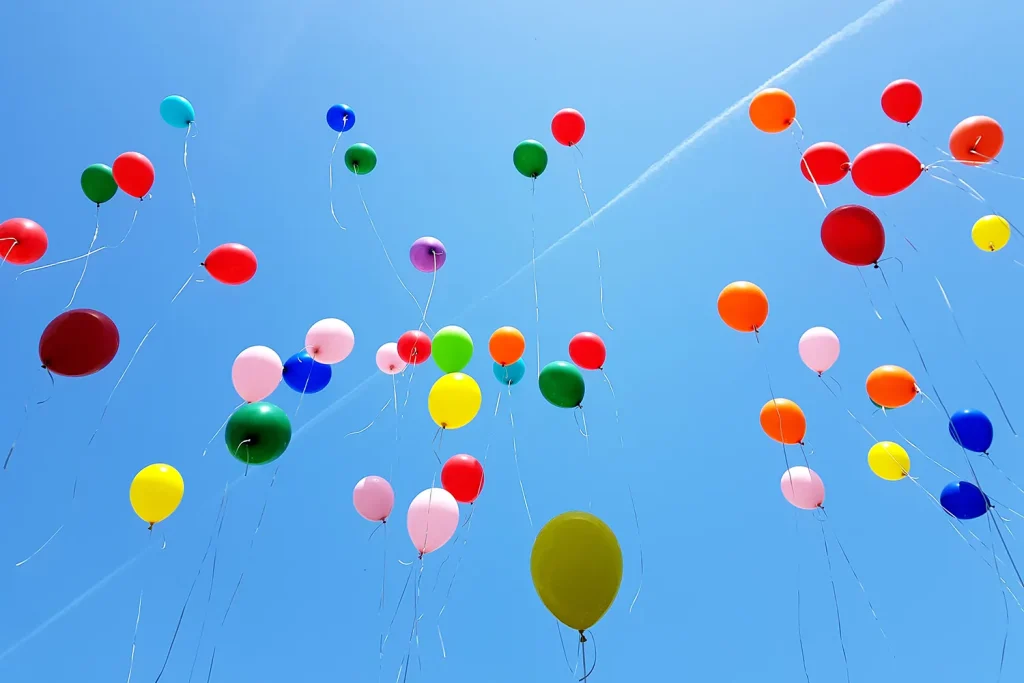The 1986 Cleveland Balloon Disaster: How a Record-Breaking Fundraiser Turned Into One of the City’s Most Chaotic and Costly Days Ever
It was supposed to be the day Cleveland floated back into the national spotlight — literally. On September 27, 1986, the city released one and a half million helium-filled balloons into the sky in what was meant to be a dazzling, record-breaking fundraising stunt. Organized by United Way of Cleveland and promoted as a symbol of hope, pride, and rebirth for a city still clawing its way out of the shadows of economic decline, the event was called Balloonfest ‘86. But within hours, that burst of color and optimism would collapse into one of the most bizarre and devastating civic disasters in American history — a surreal day when the sky rained balloons, chaos gripped the streets, and every good intention went painfully wrong.

The idea sounded simple enough. The mid-1980s had been tough for Cleveland. The city had battled bankruptcy, crumbling infrastructure, and a national reputation as a symbol of decline. The Cuyahoga River catching fire in 1969 had become a cruel punchline, and city leaders were desperate to change the narrative. When the United Way proposed a massive balloon release to break the world record — then held by Disneyland for launching 1 million balloons — it seemed like a harmless, feel-good project. The event would raise money for charity, showcase the city’s community spirit, and capture the imagination of the world.
In the weeks leading up to the event, the city’s Public Square transformed into a construction site. A giant rectangular structure, roughly the size of a city block, was erected and covered with netting. Volunteers, including thousands of schoolchildren and local residents, worked tirelessly to fill balloons inside the structure. Sponsored by Balloonart by Treb, a California-based company specializing in large-scale balloon events, the project required tons of helium, hundreds of workers, and relentless coordination.

By the morning of September 27, anticipation had reached fever pitch. Streets filled with onlookers, media crews crowded the area, and children gathered, holding onto balloon-themed souvenirs. The sky was cloudy, the wind was picking up, but excitement drowned out any concerns. Helicopters hovered overhead, and Cleveland’s downtown buzzed with a rare sense of unity. Around 1:50 p.m., the nets were released.
What followed was nothing short of mesmerizing.
For a few brief minutes, the sky above Cleveland became a swirling canvas of color — millions of red, yellow, blue, and orange balloons rising together, twisting in the wind, reflecting light in a kaleidoscopic storm. Witnesses described it as “magical,” “otherworldly,” and “the most beautiful chaos” they had ever seen. News anchors called it a “celebration of Cleveland’s comeback.” Cameras rolled as the balloons soared higher, forming rivers of color that stretched for miles.
But that wonder didn’t last long.
Within minutes, strong winds and cold air currents pushed the balloons back down toward the city and Lake Erie. Instead of drifting away peacefully, they began to descend — in parking lots, on highways, in neighborhoods, on runways, and across the lake’s surface. What was supposed to be an uplifting symbol of unity quickly became a logistical nightmare.
Airports had to halt takeoffs. Drivers on the Shoreway and nearby interstates swerved to avoid balloons blocking their vision. Horses at a local racetrack spooked and bolted. And as the colorful orbs blanketed Cleveland and its suburbs, the true scale of the chaos became clear. The sky was so filled with drifting helium that rescue helicopters couldn’t navigate safely. And tragically, this would soon prove fatal.

That same afternoon, two fishermen — Raymond Broderick and Bernard Sulzer — had gone missing on Lake Erie. When the Coast Guard attempted to locate their boat, they faced an impossible task: the entire surface of the lake was covered in thousands of colorful balloons, each bobbing like a head in the water. The rescuers couldn’t distinguish waves from wreckage or balloons from possible victims. After hours of searching, they were forced to retreat. The fishermen’s bodies were found two days later. Their families later sued the United Way of Cleveland, alleging that the balloon release had directly hindered rescue efforts.
It wasn’t the only lawsuit. Another came from a woman whose horses suffered injuries after being frightened by falling balloons. Cleveland’s airport filed complaints over disrupted air traffic. Cleanup crews were overwhelmed. The city spent days trying to gather the deflated latex fragments that littered streets, trees, and waterways. What had started as a record-breaking celebration ended with lawsuits, environmental damage, and a scarred public image.

Environmentalists were quick to condemn the event. Even though organizers had promoted the balloons as biodegradable, experts pointed out that the materials could take months or even years to fully break down — posing serious risks to wildlife and marine life. Birds and fish could easily mistake the remnants for food. In the following weeks, the edges of Lake Erie and nearby communities were strewn with balloon debris. “It was like the aftermath of a parade that never ended,” one local recalled.
The record itself — 1,429,643 balloons, confirmed by Guinness World Records — was short-lived. The title was quietly retired, and no one has attempted a similar mass release since. In the years that followed, Balloonfest ‘86 became a cautionary tale told in documentaries, classrooms, and environmental campaigns about the unforeseen consequences of spectacle.
For Cleveland, the event was meant to be a metaphor for renewal — a statement that the city could rise above its hardships. Instead, it became a lesson in how ambition without foresight can turn into disaster. “Everything that could go wrong went wrong,” said one organizer in a later interview. “We thought we were doing something beautiful. We didn’t realize we were creating a storm.”
The irony is that Balloonfest wasn’t born out of negligence or greed — it was an act of optimism. It reflected a city trying to believe in itself again. In 1986, Cleveland’s economy was struggling, its reputation tarnished. The balloon release was an attempt to rewrite that story, to capture national attention for something joyful. The people who filled and released those balloons weren’t careless; they were hopeful. They wanted to see color in a gray skyline.
Today, nearly four decades later, the images from that day remain breathtaking — and haunting. The iconic photograph of balloons cascading over Cleveland’s Terminal Tower looks almost unreal, like a painting of celebration frozen in time. But behind that photo lies the sobering truth of what followed. The cleanup took weeks. The lawsuits dragged on for years. The environmental impact lasted much longer.
In retrospect, Balloonfest ‘86 feels like a symbol of the 1980s itself — a decade defined by spectacle, optimism, and the belief that bigger was always better. It was a time when cities competed for records, corporations chased grand gestures, and visual impact often outweighed long-term planning. But as Cleveland learned that day, even the brightest celebrations can cast long shadows.
Survivors and witnesses still recall it with mixed emotions. Some remember the wonder of those first few minutes, the surreal beauty of a sky filled with color. Others can’t forget the chaos that followed. “It was one of those moments you never forget,” said one resident. “You didn’t know whether to smile or cry.”
In the end, Balloonfest ‘86 became one of Cleveland’s most unforgettable events — not for the record it broke, but for the hard lessons it taught. What began as a vision of unity ended as a warning about consequence. It showed how easily human optimism can drift into hubris, how even a celebration of good intentions can spiral into tragedy when nature refuses to cooperate.
Nearly forty years later, as photos from that fateful day continue to circulate online, Balloonfest serves as both a time capsule and a cautionary tale. It’s a reminder that progress isn’t about grand gestures or record-breaking numbers. Sometimes, it’s about knowing when to let an idea stay grounded.


